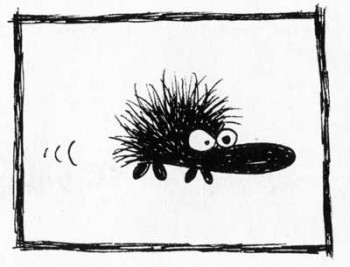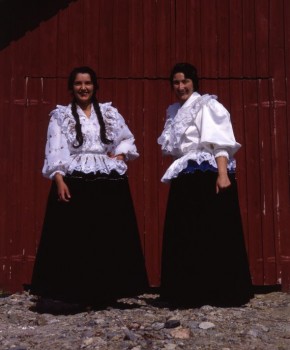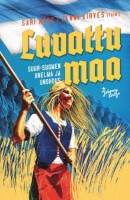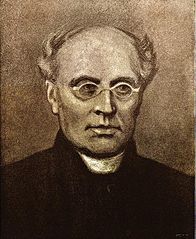Search results for "sari mikkonen"
Funny stuff
1 April 2009 | In the news

Milla Paloniemi's swearing hedgehog
For the first time, comic books rule the latest bestsellers list of Finnish fiction.
A cartoon series called Fingerpori by Pertti Jarla evidently tickles the Finnish funny bone, as three of his collections occupy the second, sixth and eighth places on the February top ten list, compiled by the Booksellers’ Association of Finland. More…
On the road, in the world
21 March 2013 | Reviews

In Romani dress: Finnish Romani women still wear their traditional velvet skirts (which weigh 5-8 kilos). Photo: Topi Ikäläinen, 1983
Suomen romanien historia
[A history of Finland’s Romani people]
Toimittanut [Edited by] Panu Pulma
Helsinki: Suomalaisen Kirjallisuuden Seura (the Finnish Literature Society), 494 p., ill.
ISBN 978-952-222-364-7
€57, hardback
The Romani people set out from India around a thousand years ago; there are those who even claim that they originated in Egypt long before that. This latter account was favoured among the Romani in Europe, and so their leaders took to styling themselves the Dukes of ‘Egypt Minor’ or ‘Little Egypt’.
The Romani of Europe are generally considered to have come from northern India in the 15th century. They arrived in Finland – which at that time was part of Sweden – in 1512.
Five hundred years later, it seems a fitting time to publish Suomen romanien historia, a volume edited by Panu Pulma, PhD, a university lecturer in Finnish and Nordic history, with chapters contributed by a total of 14 additional experts.
The Romani who reached Stockholm, also in 1512, were said to be from ‘Egypt Minor’. This purported connection with Egypt is the origin behind the English word gypsy. The Swedish word zigenare (related to the German Zigeuner) did not come into use until the 17th century. More…
Luvattu maa. Suur-Suomen unelma ja unohdus [The promised land. The dream of Greater Finland, and how it was forgotten]
26 September 2014 | Mini reviews, Reviews
 Luvattu maa. Suur-Suomen unelma ja unohdus
Luvattu maa. Suur-Suomen unelma ja unohdus
[The promised land. The dream of Greater Finland, and how it was forgotten]
Toim. [Ed. by] Sari Näre & Jenni Kirves
Helsinki: Johnny Kniga, 2014. 407 p.
ISBN 978-951-0-40295-5
€36.90, hardback
In the 1920s and 1930s Finland was powerfully influenced by the idea of a Greater Finland which was also to include the Finno-Ugric peoples living on the Soviet side of the border – at least East Karelia, if not more. Right-wing nationalists in particular nourished a vision that had its roots in the idealistic ‘Karelianism’ of the nineteenth century. When during the Second World War in 1941 Finland ended up fighting the Soviet Union as an ally of Nazi Germany, and the Finnish army advanced far beyond the eastern border, for a short time many Finns even viewed a Greater Finland as a possibility. After Finland suffered defeat in the war there was a desire to forget both the embarrassing alliance with Nazi Germany and the frenzied nationalistic dreams of Greater Finland with their population resettlements and other plans. Not until the 1970s did anyone begin to study the subject in more depth. Five historians from a younger generation present a fascinating study of the Greater Finland idea and the attempts at its realisation, discussing, for example, the attitude to the war taken by women and the clergy, life at the front line, and propaganda, including its expression in literature.
Translated by David McDuff
Nine lives
30 September 1994 | Archives online, Fiction, Prose
Entire lives flash by in half a page in this selection of very short short stories. Extracts from Elämiä (‘Lives’, Otava, 1994)
Silja
Silja was born in 1900. The home farm had been sub-divided many times. Silja threw a piece of bread on the floor. ‘Don’t sling God’s corn,’ said grandmother. Silja got up to go to school at four. In the cart, her head nodded; when the horse was going downhill its shoes struck sparks in the darkness. Silja’s brother drove to another province to go courting. Silja sat in the side-car. ‘The birches were in full leaf there,’ she said at home. Silja went to Helsinki University to read Swedish. She saw the famous Adolf Lindfors playing a miser on the big stage at the National Theatre. Silja got a senior teaching post at the high school. With a colleague, she travelled in Gotland. Silja donated her television set to the museum. It was one of the first Philips models. ‘Has this been watched at all?’ they asked Silja. Silja learned to drive after she retired. She called her car ‘The Knight’. The teachers’ society made a theatre trip to Tampere. Silja looked up her colleague in the telephone directory in the interval. There was no one of that name. More…
3 x Runeberg: poet, cake & prize
5 February 2014 | This 'n' that

J.L. Runeberg. Painting by Albert Edelfelt, 1893. WIkipedia
Today, the fifth of February, marks the birthday of the poet J.L. Runeberg (1804–1877), writer, among other things, of the words of Finnish national anthem.
Runeberg’s birthday is celebrated among the literary community by the award of the Runeberg Prize for fiction; the winner is announced in Runeberg’s house, in the town of Borgå/Porvoo.

Runeberg’s favourite. Photo: Ville Koistinen
Mrs Runeberg, a mother of seven and also a writer, is said to have baked ‘Runeberg’s cakes’ for her husband, and these cakes are still sold on 5 February. Read more – and even find a recipe for them – by clicking our story Let us eat cake!
The Runeberg Prize 2014, worth €10,000, went to Hannu Raittila and his novel Terminaali (‘Terminal’, Siltala).

Hannu Raittila. Photo: Laura Malmivaara
According to the members of the prize jury – the literary scholar Rita Paqvalen, the author Sari Peltoniemi and the critic and writer Merja Leppälahti – they were unanimous in their decision; however, the winner of the 2013 Finlandia Prize for Fiction, Jokapäiväinen elämämme (‘Our everyday lives’) by Riikka Pelo, was also seriously considered.
Read more about the 2014 Runeberg shortlist In the news.
Who for? On new books for children and young people
29 January 2010 | Articles, Non-fiction
Books have a tough time in their struggle for the souls of the young: more titles for children and young adults than ever before are published in Finland, all of them trying to find their readers. Päivi Heikkilä-Halttunen picks out some of the best and most innovative reading from among last year’s titles
Nine-year-old Lauha’s only friend and confidant is her teddy bear Muro, because Lauha is an outsider both at home and at school. The children’s novel Minä ja Muro (‘Muro and me’, Otava), which won the 2009 Finlandia Junior Prize, provoked discussion of whether it was appropriate for children, with its oppressive mood and the lack of any bright side brought into the life of the main character in its resolution. More…

